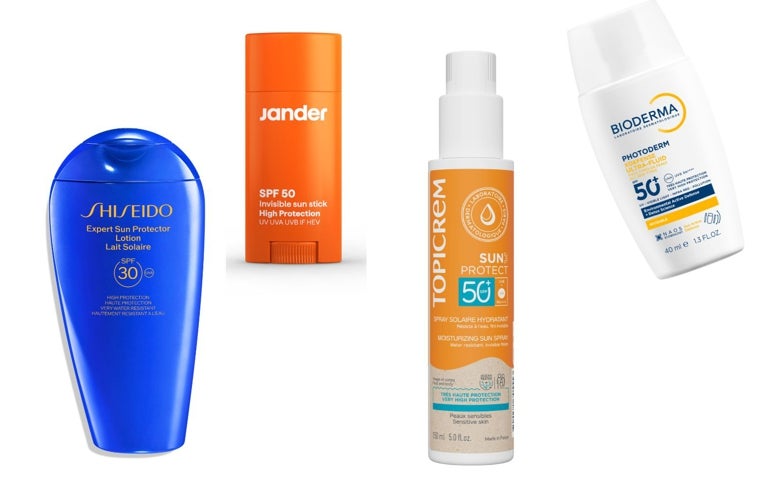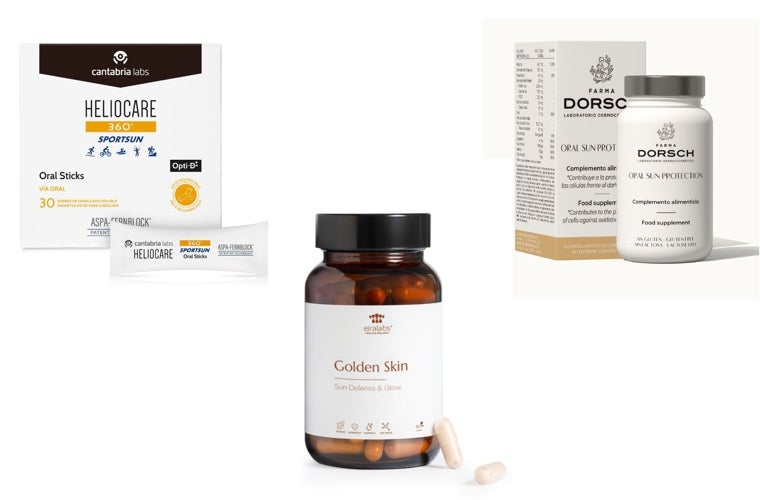Tanning without burning: The ultimate guide to protecting your skin this summer

Swimming pools and beaches are now the most popular places to enjoy the summer. But the sun's rays are not harmless, and many people often get sunburned. Sunburn is uncomfortable and, in the long run, can cause skin cancer. That's why it's so important to take precautions and limit sun exposure. Although it's important to be aware that a healthy tan doesn't exist (unless it's caused by self-tanners), it's very common to seek a darker skin tone than the one you show off in winter. To achieve this without getting burned, keep some tips in mind.
Trends like sun calluses and sun tattoos are very risky, as Dr. Javier Pedraz , a dermatologist at IML Clinic, explains: "It's a form of deliberate sunburn, and every time your skin burns, it increases your risk of developing skin cancer in the future." That's why the first piece of advice is to always use sunscreen generously on all exposed areas of the body (don't forget your ears, insteps, hands, and bald spots).
When in doubt, experts advise choosing sunscreens with SPF 50 or at least SPF 30 , and preferably broad-spectrum photoprotection, which protects against UVB, UVA, infrared, and blue light rays (this should be indicated on the cream packaging).
In addition, it's a good idea to use a specific cream for the face and another for the body. Don't forget to reapply every two hours , whenever you're exposed, and after swimming, even if it's a water-resistant product. It's essential to be generous with sunscreen, because using too little doesn't protect you.
 From left to right: Shiseido Blue Expert Sun Protector Lotion SPF30 (€51.50), a family-sized face and body protection product; Jander Invisible Sun Stick SPF 50 (€21.90), broad-spectrum, water-resistant protection; Topicrem Sun Protect Spray SPF50+ (€17.95), photoprotection for sensitive skin on the face and body; Bioderma Photoderm XDefense Ultra-Fluid SPF 50+ (€21.95), a detoxifying face sunscreen with a minimalist, high-tolerance formula.
DR
From left to right: Shiseido Blue Expert Sun Protector Lotion SPF30 (€51.50), a family-sized face and body protection product; Jander Invisible Sun Stick SPF 50 (€21.90), broad-spectrum, water-resistant protection; Topicrem Sun Protect Spray SPF50+ (€17.95), photoprotection for sensitive skin on the face and body; Bioderma Photoderm XDefense Ultra-Fluid SPF 50+ (€21.95), a detoxifying face sunscreen with a minimalist, high-tolerance formula.
DR
In addition to sunscreen, to avoid sunburn, you should wear hats, caps, sunglasses, umbrellas, and UV-protective clothing , especially to protect the most sensitive areas that are prone to redness: the face, shoulders, chest, etc.
Sun exposure should be gradual, always avoiding the central hours of the day (between 11 a.m. and 5 p.m.), when UV rays are most potent.
What we eat is reflected in our skin, and that's why diet also plays a crucial role in tanning, as explained by Dr. María José Crispín , nutritionist at Clínica Menorca. "Certain foods can stimulate melanin production and strengthen the skin's defenses against sun damage. The key is to include nutrients with antioxidant functions or directly involved in melanin synthesis ." Among the foods that prepare the skin for the sun, the doctor includes "beta-carotenes, natural pigments with antioxidant action and precursors of vitamin A, which promote melanin production. They are present in orange and red fruits and vegetables : carrots, pumpkin, apricots, peaches, loquats, watermelon, tomatoes... Also in green vegetables such as spinach, chard, and broccoli. Another interesting nutrient is L-tyrosine, an amino acid that is a direct precursor of melanin. It is abundant in legumes, nuts, seeds, avocados, and bananas. Furthermore, vitamin E, present in foods such as extra virgin olive oil , nuts, and avocado, may promote pigmentation thanks to its antioxidant effect. It's also essential to stay properly hydrated by drinking water.
Years ago, sunscreen nutricosmetics were used to accelerate tanning; now, many doctors and pharmacists recommend them to protect the skin from within. Supplements reach where creams can't, and for Eduardo Senante , pharmacist and owner of farmaciasenante.com , "they're not necessary, but they are recommended. No one applies the recommended amount of cream, which is two milligrams per square centimeter of skin, and no one reapplies every two hours... Although it's highly recommended for people with sun allergies, a history of skin cancer or melanoma, inflammatory conditions such as rosacea, skin prone to blemishes, or those concerned about aging, everyone can use them because sunscreen nutricosmetics will better protect our skin from ultraviolet radiation . It would be advisable to use them mainly during the spring and summer months, and it's important to choose brands with scientific evidence. Furthermore, you should always be aware that they're not a substitute for sunscreen."
 From left to right: Heliocare 360º Sport Sun Sticks by Cantabria Labs (18 euros), a food supplement with vitamins and minerals and the new ASPA-Fernblock® technology to protect against sun damage; Golden Skin by Eiralabs (45 euros), its exclusive combination of Melatine®, Nutroxsun® and Puredia SeaBerry®, helps to obtain a faster, more uniform and longer-lasting tan, while protecting the skin from within; Oral Sun Protection by Farma Dorsch (40.20 euros), solar nutricosmetics with antioxidants, carotenoids, vitamins, minerals and niacinamide and polypodium leucotomos.
From left to right: Heliocare 360º Sport Sun Sticks by Cantabria Labs (18 euros), a food supplement with vitamins and minerals and the new ASPA-Fernblock® technology to protect against sun damage; Golden Skin by Eiralabs (45 euros), its exclusive combination of Melatine®, Nutroxsun® and Puredia SeaBerry®, helps to obtain a faster, more uniform and longer-lasting tan, while protecting the skin from within; Oral Sun Protection by Farma Dorsch (40.20 euros), solar nutricosmetics with antioxidants, carotenoids, vitamins, minerals and niacinamide and polypodium leucotomos.
After a day at the pool or beach, it's important to take care of your skin, both your body and your face. The most important steps are two: cleansing and moisturizing . You must cleanse your skin (both your face and body) to remove traces of sunscreen , as well as other residues, such as chlorine or sea salt. Next, apply moisturizers , because drinking water doesn't hydrate your skin. As experts assure, tanning always represents sun damage, so you must repair the skin barrier by applying restorative and regenerative creams. You can use after-sun lotions or aloe vera on your body. For your face, use creams with hyaluronic acid, ceramides, niacinamide, etc.
Finally, it's important to keep in mind that not everyone can tan, as explained by Dr. Marta González , a surgical dermatologist at IMR. "Melanin is the pigment responsible for darkening the skin after sun exposure. Therefore, a tan—which is never healthy and indicates damage to our skin—is determined by the skin's ability to produce melanin. Something very important regarding quality and quantity is that patients with low phototypes, that is, with light eyes and/or blond or red hair, produce 'poorer quality' melanin, so when exposed to the sun, they will burn and not tan . Although everyone should use sunscreen and avoid direct exposure during the central hours of the day, this subgroup of people has a higher risk of developing skin cancer, so they must be even stricter with photoprotection."
abc





